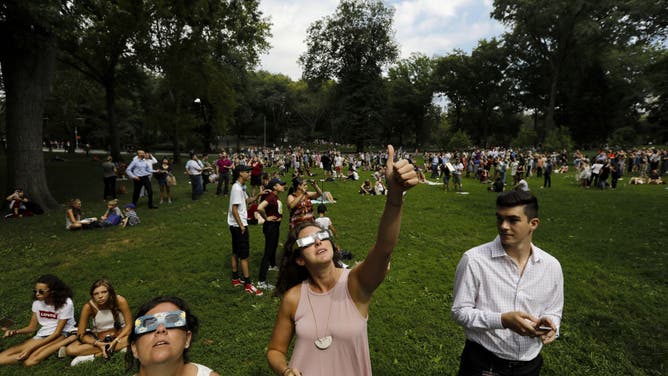Where to see the total solar eclipse in New York on April 8th
On April 8th, a total solar eclipse will sweep from Texas to Maine, offering millions the chance to see totality. Here’s what you need to know about viewing the eclipse in New York.
New York's Homesteads for Hope turning 55-acre farm into prime solar eclipse viewing experience
A farm in upstate New York is offering the ultimate total solar eclipse viewing experience on Monday. Homesteads for Hope is a non-profit community farm for adults with and without disabilities to learn, work, someday live and every day grow in nature's classroom.
New York is among the last states to experience America's total solar eclipse on April 8th when the Moon blocks out the Sun, casting Buffalo, Rochester and the Adirondacks in darkness for a few minutes on Monday afternoon and producing a partial eclipse in New York City.
FOX WEATHER WIRE LIVE COVERAGE: TOTAL SOLAR ECLIPSE APRIL 2024
Here’s what you need to know about viewing the eclipse in New York.
What is a total solar eclipse?
A total solar eclipse happens when the Moon passes between the Sun and the Earth, completely blocking the face of the Sun for several minutes.
From partial eclipse through totality, the process takes several hours. The final moments before totality include displays of light known as Baily's Beads and the Diamond Ring caused by the pock-marked surface of the Moon.
Where can I see the total solar eclipse in New York?
The maximum total solar eclipse known as totality will be visible across a section of the state from the southwest corner of New York to the Canadian and Vermont borders.
This will be the first total solar eclipse for New York in 99 years.
Totality will cast a dusk-like shadow on the cities of Buffalo, Rochester, Niagara Falls, Syracuse, Watertown and Massena.
Before the eclipse moves into Vermont, New York's Adirondacks region will be the last to see a total solar eclipse. Areas including Blue Mountain Lake, Indian Lake, Lake Placid and Jay Village will be in the path of totality.
A partial eclipse will be visible across the entire state of New York, including nearly 87% in New York City. Areas just outside the path of totality such as Utica will see nearly a total eclipse with 99.7% of the Sun covered.

The path of totality through New York on April 8, 2024.
(FOX Weather)
What time is the solar eclipse in 2024?
The first cities in New York to see totality will be near the New York-Pennsylvania state line, including Westfield at 3:17 p.m. with 3 minutes and 42 seconds of totality.
A partial eclipse begins in Buffalo and Niagara Falls at 2:05 p.m. with totality at 3:18 p.m. Buffalo will have 3 minutes and 46 seconds of near darkness.

Eclipse timing in Buffalo, New York, on April 8, 2024.
(FOX Weather)
Rochester will fall into near darkness at 3:20 p.m. for 3 minutes and 41 seconds of totality.
Lake Placid will be in totality for 3 minutes and 21 seconds, with totality beginning at 3:25 p.m.
New York City will experience a partial eclipse at 3:25 p.m. with just a sliver of the Sun's face visible around the Moon. Much closer to the path of totality, Utica will see a 99% partial eclipse at 3:24 p.m.
What will the weather be like in New York for the eclipse?
A clear sky is key to watching a total solar eclipse.
TOTAL SOLAR ECLIPSE LIVE TRACKER: CLOUD FORECASTS FOR CITIES, STATES IN PATH OF TOTALITY
The FOX Forecast Center has put together the cloud cover forecast shown on the maps below, showing areas with an overcast sky, many clouds or few clouds during the eclipse.

(FOX Weather)
As the eclipse nears, computer forecast models will improve and be able to give forecasters a better idea of what the sky will look like on the big day.
TOTAL SOLAR ECLIPSE FORECAST SHOWS WHO HAS BEST CHANCE FOR CLEAR SKIES ON APRIL 8TH

(FOX Weather)
Below is a look at what to expect in the hours before and after the eclipse for New York towns along the path of totality.

(FOX Weather)

(FOX Weather)
Check back with FOX Weather for updates to the forecast as the date of the eclipse approaches, and add your viewing location to the "Events" tab in the FOX Weather app.
What to know about traveling to New York for the 2024 solar eclipse

A woman wearing solar viewing glasses, center, holds up her thumb while looking at the sun during a solar eclipse at Central Park in New York, U.S., on Monday, Aug. 21, 2017. Millions of Americans across a 70-mile-wide (113-kilometer) corridor from Oregon to South Carolina will see the sky darken as the sun disappears from view total during the eclipse. Photographer: Peter Foley/Bloomberg via Getty Images
New York Gov. Kathy Hochul said travelers should expect high volumes of traffic and be prepared for backups. The governor said New York is ready to welcome millions of visitors hoping to witness history.
HERE'S WHAT NOT TO DO DURING THE TOTAL SOLAR ECLIPSE ON APRIL 8TH
According to Airbnb booking data for April 8th, Buffalo is among the most popular cities along the path of totality.
Other popular spots to watch the eclipse are in state parks. New York State Parks released a list of parks with available viewing locations.
The Adirondacks region is preparing for an influx of visitors for the rare event. There are eclipse viewing events planned throughout locations in the mountains.
However, region officials said amateur hikers hoping to experience totality at a mountain peak might consider staying at lower elevations because of the unpredictable spring weather in the Adirondacks.
"In April, trail conditions in the Adirondacks are a mixed bag: higher elevations will still have snow and ice, while lower trails can be cold and muddy," the Eclipse ADK website states.
No matter where you plan to watch the eclipse, print out a map or bring an Atlas. During totality and after, internet connections and cellphone networks may be overloaded.
Plan to arrive at your viewing location early and stay long after the eclipse to avoid the most traffic. Bring plenty of food, water and sunscreen, and gas up your vehicle.
When is the next solar eclipse in New York?
After April 8, 2024, parts of New York will have to wait decades for another total solar eclipse. Portions of New York will experience several partial solar eclipses in the coming years, including next year and in 2026.
However, the next total solar eclipse in the U.S. in 2044 will only bring totality to parts of Montana and the Dakotas.
The next total solar eclipse won't be visible in New York until May 1, 2079, according to timeanddate.com.
